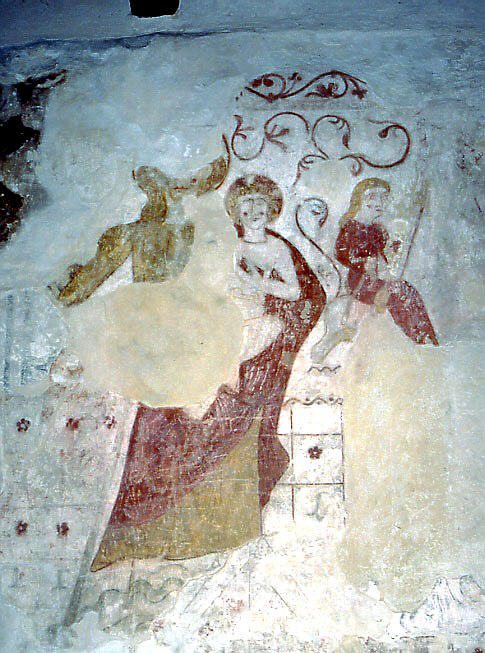East Wellow, Hampshire (†Winchester) C.13/14
St Christopher and Woman Spinning

St Christopher is at the left, wearing a yellow robe with a red cloak over it. Most of his face and head, also painted in yellow, have gone, but part of his halo and his chin are still visible, along with the lower part of his robe and cloak. Christopher holds the Christ Child at the right, wrapped in his red cloak. The Child has the tripartite halo proper to Persons of the Trinity, and his red-highlighted cheeks are probably an unfortunate effect of an early restoration.
The details surrounding the two central figures are slightly confusing. A sea-serpent, just visible below the left lower edge of Christopher’s robe, undulates along, but there are other obscured lines and shapes here that might have been part of a naturalistic riverbank scene, or part of some other subject entirely. But the patch of pigment at the top left of the picture is almost certainly the remains of the Hermit with his lantern.
To the right of the Christ Child is a seated woman with long yellow hair, who is apparently spinning. Visible at one time to the right beyond her was ‘a knight with a sword and two keys, arriving to rescue her’. A few faint traces of what may be the keys still remain. Further to the left of St Christopher, above the North Door, are the remains of a scene showing the corner of a castle(?) wall with a battlemented parapet and two figures looking out from it. EW Tristram thought the spinning woman was St Margaret – the man arriving to ‘rescue’ her being the prefect Olybrius of Antioch who according to most versions of her legend found her working as a shepherdess and seduced her. On the remaining evidence it is impossible to be sure – the fact that the church is dedicated to St Margaret need not imply that she is painted there, but given Margaret’s popularity, this interpretation is plausible enough. There are several Consecration Crosses and other fragmentary remains of painting elsewhere in the church, including a figure in a window-splay said to be St Edmund Rich (Edmund of Abingdon), and a painting of the Martyrdom of Thomas Becket is recorded as visible once. All otherwise empty space on the walls seems at one time to have been painted with the ‘stoning and roses’ pattern, combined with scrollwork, visible in the St Christopher.
The parish now served by the church of St Margaret of Antioch at East Wellow was originally in the possession of King Alfred the Great of Wessex. He gave it to his formidable daughter Aethelfleda, who married into the Mercian royal family and became in due course its effective co-ruler. The present church was founded in 1215, and this may be the original painted scheme, dating perhaps from sometime soon after Edmund Rich was canonized in 1246. Some earlier scholars assign the paintings to the thirteenth century and some to the fourteenth (Caiger-Smith). On stylistic grounds it is very difficult to be certain, but a little before, rather than a little after, 1300, seems most likely to me.
Website for St Margaret’s, East Wellow
† in page heading = Diocese